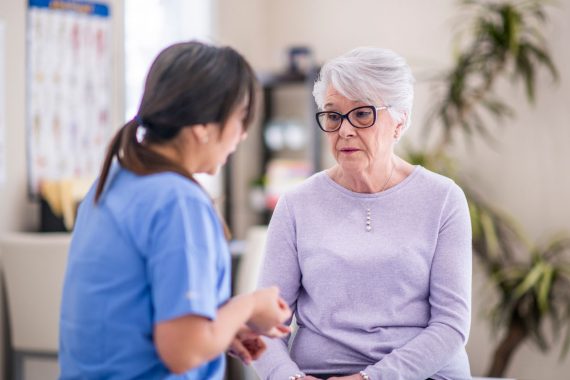NICE has rubberstamped guidance aimed at reducing the number of falls among older people which GPs had previously warned may be difficult to implement.
Since the consultation on draft falls guidelines last year, NICE has widened its recommendation on who can carry out ‘personalised’ home hazard assessments, from only occupational therapists to a range of healthcare professionals.
There had been concern, echoed by GPs, about barriers to implementing the guidance due to workforce shortages among occupational therapists in some areas.
As such, the NICE committee recognised that other professionals such as physiotherapists and nurses can deliver home hazard assessments and interventions – but it maintained that occupational therapists are the ‘optimal method of service delivery’.
The updated guidelines, published in its final version today and covering people aged over 65 or those aged 50 to 64 years with a condition that increases their risk of falling, advises a comprehensive falls assessment and management for people who:
- have fallen in the past year and are living with frailty;
- were injured in a fall;
- experienced loss of consciousness;
- have been unable to get up independently after a fall, or;
- have had two or more falls.
NICE said such assessments – which aim to identify a person’s risk factors for falling – can be carried out by an ‘appropriately trained’ healthcare professional in primary care or other community settings.
The committee recognised that it ‘would not always be practical’ to carry out an assessment in every scenario as ‘not every service would have the expertise or time to carry this out’.
It therefore recommended ‘appropriate’ referrals, citing an example where a risk factor is identified in hospital outpatients but then communicated to the GP via the usual appointment letter.
The guidelines also said that ‘some assessments could easily be done in primary care’, such as blood pressure and medication checks, whereas ‘others may require referral to a specialist’.
Structured medication reviews should be used to identify any medicines that increase the risks of falls and how they may be adjusted, the guidance also said.
The recommendations also noted that falls risk prediction tools should not be used to predict a person’s risk of falling.
NICE highlighted that in 2022/23 there were around 210,000 emergency hospital admissions in England related to falls for people aged 65 and over.
Fragility fractures cost the UK an estimated at £4.4bn which includes £1.1bn for social care. Hip fractures alone account for around £2bn of this sum.
NICE chief medical officer Professor Jonathan Benger said that ‘fewer people suffering falls will result in a drop in the number of hospital visits’ and therefore ‘reduce pressure on the NHS’.
‘This useful and useable guideline has been updated to ensure people identified as being at greatest risk get help and support tailored to their individual needs so they can live full and active lives,’ he added.
NHS national clinical director for older people Dr Tom Downes said: ‘Identifying those at greatest risk of falls and providing them with the preventative help and support they need will not only improve people’s lives, but it will also free up clinical time and resource too.’
NICE recommendations on falls: assessment and prevention in older people and in people 50 and over at higher risk
1.1.1 Do not use falls risk prediction tools to predict a person’s risk of falling.
Identifying risk in community settings
1.1.2 In community settings, ask people about the details of any falls. This can be done:
- when a person presents after a fall or
- by opportunistically asking people (for example, in routine appointments and annual health checks) whether they have fallen in the last year.
1.1.3 Offer a comprehensive falls assessment and comprehensive falls management to people who have fallen in the last year and meet any of the following criteria (this can be carried out in the same service or involve an appropriate referral):
- Are living with frailty.
- Were injured in a fall and needed medical (including surgical) treatment.
- Have experienced a loss of consciousness related to a fall.
- Have been unable to get up independently after a fall.
- Have had 2 or more falls in the last year.
1.1.5 For people who have fallen in the last year who have a gait or balance impairment:
- offer a falls prevention exercise programme and
- consider a home hazard assessment
Comprehensive falls assessment
1.2.2 Include the following assessments and examinations (where appropriate) in the comprehensive falls assessment to identify the person’s individual fall risk factors:
- Alcohol misuse.
- Cardiovascular examination (including a lying and standing blood pressure test).
- Cognition and mood.
- Delirium.
- Diet, fluid intake and weight loss.
- Dizziness: ask about the presence and nature of any dizziness; if the person reports symptoms of rotational vertigo, consider performing a Dix–Hallpike manoeuvre.
- Footwear and foot condition.
- Functional ability: assess the person’s perceived functional ability and explore any concerns about falling.
- Gait, balance and mobility, and muscle strength assessment.
- Hearing impairments.
- Long-term conditions that affect the person’s daily life, for example, arthritis, dementia, diabetes or Parkinson’s disease.
- Medication review.
- Neurological examination.
- Osteoporosis risk assessment.
- Urinary continence.
- Visual impairments.
1.2.3 Ensure that the person’s individual risk factors identified in the comprehensive falls assessment are promptly addressed with appropriate interventions to reduce their risk of falls. These interventions can be offered in the same service or involve an appropriate referral.
Interventions
1.3.2 Consider carrying out a structured medication review:
- to identify any medicines that may increase the person’s risk of falls and
- consider adjusting their medicines to reduce that risk.
1.3.5 Offer a home hazard assessment and intervention using a validated tool.
1.3.9 Consider a falls prevention exercise programme for people who need comprehensive assessment and management.
Source: NICE












